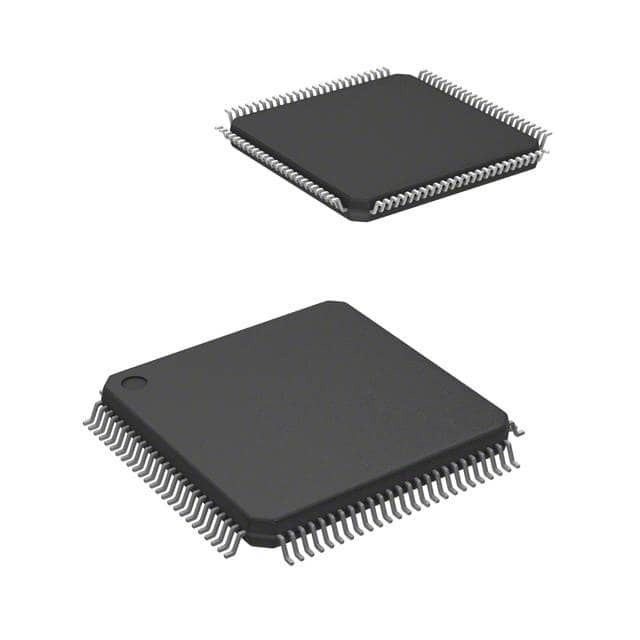STM32F103VDT6TR
Product Overview
- Category: Microcontroller
- Use: Embedded systems, Internet of Things (IoT) devices, industrial applications
- Characteristics: High-performance, low-power consumption, rich peripheral set, extensive development ecosystem
- Package: LQFP64
- Essence: ARM Cortex-M3 core microcontroller
- Packaging/Quantity: Tape and reel, 2500 units per reel
Specifications
- Core: ARM Cortex-M3
- Clock Speed: Up to 72 MHz
- Flash Memory: 256 KB
- RAM: 64 KB
- Operating Voltage: 2.0V - 3.6V
- Digital I/O Pins: 37
- Analog Input Pins: 10
- Communication Interfaces: UART, SPI, I2C, USB, CAN
- Timers: 3 x 16-bit, 1 x 32-bit
- ADC Resolution: 12-bit
- PWM Channels: 15
- Operating Temperature Range: -40°C to +85°C
Detailed Pin Configuration
The STM32F103VDT6TR microcontroller has a total of 64 pins. Here is the detailed pin configuration:
- Pins 1-8: GPIO or alternate functions
- Pins 9-16: GPIO or alternate functions
- Pins 17-24: GPIO or alternate functions
- Pins 25-32: GPIO or alternate functions
- Pins 33-40: GPIO or alternate functions
- Pins 41-48: GPIO or alternate functions
- Pins 49-56: GPIO or alternate functions
- Pins 57-64: GPIO or alternate functions
Functional Features
- High-performance ARM Cortex-M3 core for efficient processing
- Rich peripheral set including UART, SPI, I2C, USB, and CAN interfaces
- Extensive development ecosystem with support for various development tools and software libraries
- Low-power consumption for energy-efficient applications
- Flexible clocking options for optimizing performance and power consumption
- Advanced analog features such as 12-bit ADC and PWM channels
- Robust operating temperature range for industrial applications
Advantages and Disadvantages
Advantages: - Powerful ARM Cortex-M3 core for high-performance applications - Rich peripheral set enables versatile connectivity options - Extensive development ecosystem simplifies software development - Low-power consumption extends battery life in portable devices - Wide operating temperature range allows for use in harsh environments
Disadvantages: - Limited flash memory and RAM compared to higher-end microcontrollers - LQFP64 package may not be suitable for space-constrained designs - Steeper learning curve for beginners due to the complexity of ARM architecture
Working Principles
The STM32F103VDT6TR microcontroller is based on the ARM Cortex-M3 core, which provides a powerful processing engine for embedded systems. It operates at a clock speed of up to 72 MHz and offers a wide range of peripherals for communication, data acquisition, and control.
The microcontroller executes instructions stored in its flash memory and interacts with external devices through its GPIO pins and communication interfaces. It can be programmed using various development tools and software libraries, allowing developers to create custom applications tailored to their specific needs.
Detailed Application Field Plans
The STM32F103VDT6TR microcontroller finds applications in various fields, including:
- Industrial Automation: Used in control systems for monitoring and controlling machinery in factories.
- Internet of Things (IoT): Enables connectivity and data processing in IoT devices for smart homes, agriculture, and healthcare.
- Consumer Electronics: Powers devices such as home appliances, wearable devices, and gaming peripherals.
- Automotive: Used in automotive electronics for functions like engine management, dashboard displays, and infotainment systems.
- Medical Devices: Enables the development of medical devices such as patient monitors, infusion pumps, and diagnostic equipment.
Detailed and Complete Alternative Models
- STM32F103C8T6: Similar to STM32F103VDT6TR but with a smaller flash memory and package (48 KB flash, LQFP48 package).
- STM32F407VGT6: Higher-end microcontroller with an ARM Cortex-M4 core, more flash memory, and additional features.
- PIC32MX795F512L: Microcontroller from Microchip with similar capabilities and peripherals.
- LPC1768: Microcontroller from NXP with an ARM Cortex-M3 core and comparable features.
- ATmega328P: Microcontroller from Atmel with lower performance but widely used in Arduino boards.
These alternative models offer different trade-offs in terms of performance, memory, package size, and development ecosystem, allowing developers to choose the most suitable option for their specific requirements.
Word count: 530 words
Lista 10 Vanliga frågor och svar relaterade till tillämpningen av STM32F103VDT6TR i tekniska lösningar
Sure! Here are 10 common questions and answers related to the application of STM32F103VDT6TR in technical solutions:
Q: What is the STM32F103VDT6TR microcontroller? A: The STM32F103VDT6TR is a 32-bit ARM Cortex-M3 microcontroller from STMicroelectronics.
Q: What are the key features of the STM32F103VDT6TR? A: Some key features include a 72 MHz clock speed, 512 KB flash memory, 64 KB RAM, multiple communication interfaces, and various peripherals.
Q: What technical solutions can the STM32F103VDT6TR be used for? A: The STM32F103VDT6TR can be used in a wide range of applications such as industrial automation, consumer electronics, medical devices, and IoT solutions.
Q: How do I program the STM32F103VDT6TR microcontroller? A: The STM32F103VDT6TR can be programmed using various development tools and IDEs such as STM32CubeIDE, Keil MDK, or Arduino IDE with appropriate libraries.
Q: Can I use the STM32F103VDT6TR for real-time applications? A: Yes, the STM32F103VDT6TR is suitable for real-time applications due to its fast clock speed and hardware support for real-time operating systems (RTOS).
Q: What communication interfaces are available on the STM32F103VDT6TR? A: The microcontroller has USART, SPI, I2C, USB, CAN, and Ethernet interfaces, providing flexibility for various communication requirements.
Q: Does the STM32F103VDT6TR support analog-to-digital conversion (ADC)? A: Yes, the microcontroller has a built-in 12-bit ADC with multiple channels, allowing for analog sensor interfacing and data acquisition.
Q: Can I use the STM32F103VDT6TR in low-power applications? A: Yes, the STM32F103VDT6TR offers various low-power modes and features like sleep, standby, and deep power-down modes to optimize power consumption.
Q: Are there any development boards available for the STM32F103VDT6TR? A: Yes, STMicroelectronics provides development boards like the Nucleo or Discovery series that are compatible with the STM32F103VDT6TR microcontroller.
Q: Where can I find documentation and resources for the STM32F103VDT6TR? A: You can find datasheets, reference manuals, application notes, and software libraries on the official STMicroelectronics website or community forums dedicated to STM32 microcontrollers.
Please note that these answers are general and may vary depending on specific requirements and use cases.


